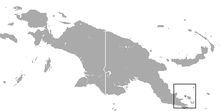
A wallaby is a small or middle-sized macropod native to Australia and New Guinea, with introduced populations in New Zealand, Hawaii, the United Kingdom and other countries. They belong to the same taxonomic family as kangaroos and sometimes the same genus, but kangaroos are specifically categorised into the four largest species of the family. The term "wallaby" is an informal designation generally used for any macropod that is smaller than a kangaroo or a wallaroo that has not been designated otherwise.
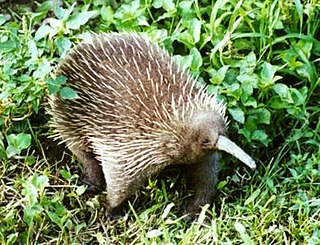
The long-beaked echidnas make up one of the two extant genera of echidnas, spiny monotremes that live in New Guinea; the other being the short-beaked echidna. There are three living species and one extinct species in this genus. The extinct species were present in Australia. Echidnas are one of the two types of mammals that lay eggs, the other being the platypus. The echidnas retain reptilian features such as egg-laying but display mammalian features such as fur and lactation.

The pig-tailed langur, monotypic in genus Simias, is a large Old World monkey, endemic to several small islands off the coast of Sumatra in Indonesia. Its face is black, its fur is blackish-brown and it has a relatively short tail. It is a diurnal species, feeding in small groups in the rainforest canopy on leaves, and to a lesser extent, fruit and berries. Little is known of its natural history, but it is heavily hunted, its populations have been declining rapidly and the International Union for Conservation of Nature has assessed its conservation status as being "critically endangered". It has been included on a list of the World's 25 Most Endangered Primates.

The dingiso, also known as the bondegezou, is an endangered, long-tailed marsupial found only in mountain forests on the west of the island of New Guinea. It is a species of tree-kangaroo, which are mammals native to Australia and New Guinea that feed on leaves or other plant matter. It belongs to the macropodid family (Macropodidae) with kangaroos, and carries its young in a pouch like other marsupials. Though sacred to the local Moni people, it is still threatened by hunting and habitat loss.

Matschie's tree-kangaroo, also known as the Huon tree-kangaroo is a tree-kangaroo native to the Huon Peninsula of northeastern New Guinea island, within the nation of Papua New Guinea. Under the IUCN classification, Matschie's tree-kangaroo is an endangered species. The scientific name honours German biologist Paul Matschie. The indigenous population refers to it as a Boongarry.

Goodenough Island in the Solomon Sea, also known as Nidula Island, is the westernmost of the three large islands of the D'Entrecasteaux Islands in Milne Bay Province of Papua New Guinea. It lies to the east of mainland New Guinea and southwest of the Trobriand Islands. It is roughly circular in shape, measuring 39 by 26 kilometres with an area of 687 square kilometres (265 sq mi) and a shoreline of 116 kilometres (72 mi). From a coastal belt varying in width from 2 to 10 kilometres in width, the island rises sharply to the summit of Mount Vineuo, 2,536 metres (8,320 ft) above sea level, making it one of the most precipitous islands in the world. The small outlier Wagifa Island lies to the south-east of the island, and is included within Goodenough's administration.

The white-sided jackrabbit, also known as the Mexican hare, is a jackrabbit found in a limited range in North America, from southern New Mexico to northwestern and central Mexico. The animal is considered threatened in New Mexico, with its numbers in decline in recent years; its presence is uncertain in Arizona.

The western brush wallaby, also known as the black-gloved wallaby, is a species of wallaby found in the southwestern coastal region of Western Australia. The wallaby's main threat is predation by the introduced red fox. The IUCN lists the western brush wallaby as Least Concern, as it remains fairly widespread and the population is believed to be stable or increasing, as a result of red fox control programs.

The red-legged pademelon is a species of small macropod found on the northeastern coast of Australia and in New Guinea. In Australia it has a scattered distribution from the tip of Cape York Peninsula in Queensland to around Tamworth in New South Wales. In New Guinea it is found in south central lowlands.
The Mount Oku hylomyscus is a species of rodent in the family Muridae. Found only on Mount Oku, Cameroon, in tropical Central Africa, its natural habitat is tropical moist montane forests. It has a very small range and is threatened by habitat destruction, so the International Union for Conservation of Nature has rated its conservation status as being "critically endangered".
The Guinean gerbil is a species of rodent found in Burkina Faso, Gambia, Ghana, Guinea, Guinea-Bissau, Ivory Coast, Mali, Senegal, Sierra Leone, and possibly Liberia. Its natural habitats are subtropical or tropical dry forests, dry savanna, rocky areas and arable land, but it is mostly found in areas laterite or clay soils, and with variable amounts of vegetation and dense scrub. This species is described as common and has a stable population and a wide distribution, so the International Union for Conservation of Nature has rated its conservation status as being of "least concern".

The grizzled tree-kangaroo is a furry, long-tailed, bear-like mammal native to tropical rainforests on the island of New Guinea. Like most tree-kangaroos, it lives in trees and eats leaves, fruit, and bark. It is a member of the macropod family Macropodidae with kangaroos, and carries its young in a pouch like other marsupials. The tree-kangaroo is uncommon and threatened by hunting and habitat loss. It is found in foothill forests of northern and western New Guinea and is indigenous to some of the offshore islands.

The ursine tree-kangaroo is a long-tailed, furry, bear-like mammal found only in tropical forests on the island of New Guinea. Slightly larger than a cat, it lives alone in trees and is active at night to feed on leaves and fruit. It belongs to the macropod family (Macropodidae) with kangaroos, and carries its young in a pouch like other marsupials. It has a small range in northwestern New Guinea and is threatened by habitat loss and hunting. Other common names for this species include the black tree-kangaroo, the Vogelkop tree-kangaroo and the white-throated tree-kangaroo.

The white-striped dorcopsis or greater forest wallaby is a species of marsupial in the family Macropodidae. It is found in the northern part of West Papua, Indonesia and Papua New Guinea. It is a common species in suitable tropical forest habitat and the IUCN lists its conservation status as being of "Least concern".
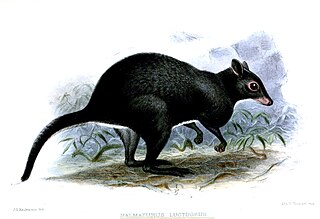
The gray dorcopsis or gray forest wallaby is a species of marsupial in the family Macropodidae. It is found in West Papua and Papua New Guinea.
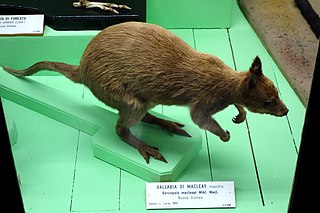
Macleay's dorcopsis, also known as the Papuan dorcopsis or the Papuan forest wallaby, is a species of marsupial in the family Macropodidae. It is endemic to Papua New Guinea, where its natural habitat is subtropical or tropical dry forest]. Being little threatened by habitat destruction, the International Union for Conservation of Nature has rated it as being of "least concern".

The black-spotted cuscus is a species of marsupial in the family Phalangeridae. It is among the largest members of the family, only being surpassed by the bear cuscus. It is a relatively colourful species found in forests of northern New Guinea. It is threatened by hunting and habitat loss, and has already disappeared from large parts of its range. Consequently, it is rated as Critically Endangered by IUCN.

Calaby's pademelon, also known as the alpine wallaby, is a species of marsupial in the family Macropodidae. It is endemic to Papua New Guinea. It is threatened by habitat loss and hunting.
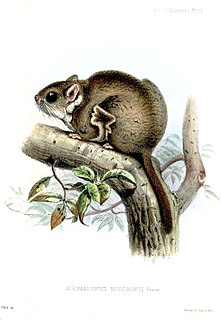
Beecroft's flying squirrel or Beecroft's scaly-tailed squirrel, is a species of rodent in the family Anomaluridae. Some authorities consider it to be monotypic within the genus Anomalurops. Its natural habitats are subtropical or tropical dry forests, subtropical or tropical moist lowland forests, and plantations. It is threatened by habitat destruction but is a common species with a wide range and the International Union for Conservation of Nature has rated its conservation status as being of "least concern".

The Sanje mangabey is a highly endangered Old World monkey of the white-eyelid mangabey group from the Eastern Arc Mountains in Tanzania. They are about 50–65 centimetres (20–26 in) in length, excluding the tail, and their body colour is greyish. Fruit makes up about 70% of their diet. They live in valley forests and on mountain slopes, but are mostly ground-dwelling, which makes them susceptible to hunting and poaching. Their habitat is being degraded, and the International Union for Conservation of Nature has assessed their conservation status as being "endangered".
